Related Research Articles
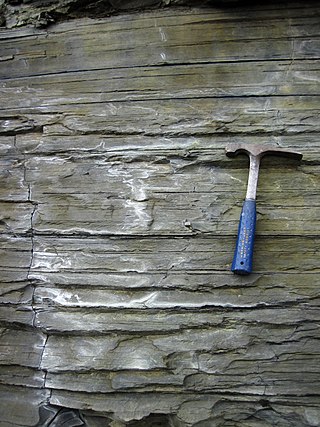
Shale is a fine-grained, clastic sedimentary rock formed from mud that is a mix of flakes of clay minerals (hydrous aluminium phyllosilicates, e.g. kaolin, Al2Si2O5(OH)4) and tiny fragments (silt-sized particles) of other minerals, especially quartz and calcite. Shale is characterized by its tendency to split into thin layers (laminae) less than one centimeter in thickness. This property is called fissility. Shale is the most common sedimentary rock.

Sedimentary rocks are types of rock that are formed by the accumulation or deposition of mineral or organic particles at Earth's surface, followed by cementation. Sedimentation is the collective name for processes that cause these particles to settle in place. The particles that form a sedimentary rock are called sediment, and may be composed of geological detritus (minerals) or biological detritus. The geological detritus originated from weathering and erosion of existing rocks, or from the solidification of molten lava blobs erupted by volcanoes. The geological detritus is transported to the place of deposition by water, wind, ice or mass movement, which are called agents of denudation. Biological detritus was formed by bodies and parts of dead aquatic organisms, as well as their fecal mass, suspended in water and slowly piling up on the floor of water bodies. Sedimentation may also occur as dissolved minerals precipitate from water solution.
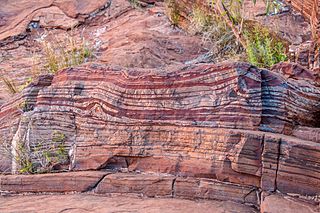
Banded iron formations are distinctive units of sedimentary rock consisting of alternating layers of iron oxides and iron-poor chert. They can be up to several hundred meters in thickness and extend laterally for several hundred kilometers. Almost all of these formations are of Precambrian age and are thought to record the oxygenation of the Earth's oceans. Some of the Earth's oldest rock formations, which formed about 3,700 million years ago (Ma), are associated with banded iron formations.
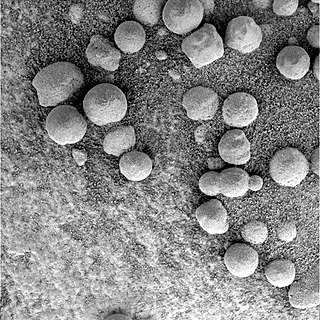
Martian spherules (also known as hematite spherules, blueberries, & Martian blueberries) are small spherules (roughly spherical pebbles) that are rich in an iron oxide (grey hematite, α-Fe2O3) and are found at Meridiani Planum (a large plain on Mars) in exceedingly large numbers.
Magnetospirillum is a Gram-negative, microaerophilic genus of magnetotactic bacteria, first isolated from pond water by the microbiologist R. P. Blakemore in 1975. They have a spiral (helical) shape and are propelled by a polar flagellum at each end of their cells. The three main species identified are M. magnetotacticum strain MS-1, M. griphiswaldense strain MSR-1, and M. magneticum strain AMB-1.

Clastic rocks are composed of fragments, or clasts, of pre-existing minerals and rock. A clast is a fragment of geological detritus, chunks, and smaller grains of rock broken off other rocks by physical weathering. Geologists use the term clastic to refer to sedimentary rocks and particles in sediment transport, whether in suspension or as bed load, and in sediment deposits.

In geology, texture or rock microstructure refers to the relationship between the materials of which a rock is composed. The broadest textural classes are crystalline, fragmental, aphanitic, and glassy. The geometric aspects and relations amongst the component particles or crystals are referred to as the crystallographic texture or preferred orientation. Textures can be quantified in many ways. The most common parameter is the crystal size distribution. This creates the physical appearance or character of a rock, such as grain size, shape, arrangement, and other properties, at both the visible and microscopic scale.
Paenarthrobacter ureafaciens KI72, popularly known as nylon-eating bacteria, is a strain of Paenarthrobacter ureafaciens that can digest certain by-products of nylon 6 manufacture. It uses a set of enzymes to digest nylon, popularly known as nylonase.

Achromobacter ruhlandii is a Gram-negative bacterium included in the order Burkholderiales.
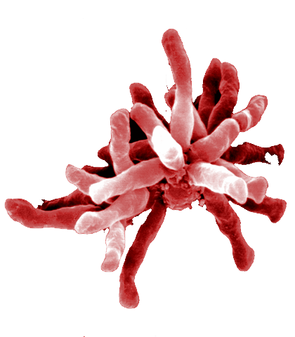
Rhodopseudomonas palustris is a rod-shaped, Gram-negative purple nonsulfur bacterium, notable for its ability to switch between four different modes of metabolism.
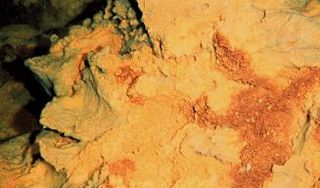
The class Zetaproteobacteria is the sixth and most recently described class of the Pseudomonadota. Zetaproteobacteria can also refer to the group of organisms assigned to this class. The Zetaproteobacteria were originally represented by a single described species, Mariprofundus ferrooxydans, which is an iron-oxidizing neutrophilic chemolithoautotroph originally isolated from Kamaʻehuakanaloa Seamount in 1996 (post-eruption). Molecular cloning techniques focusing on the small subunit ribosomal RNA gene have also been used to identify a more diverse majority of the Zetaproteobacteria that have as yet been unculturable.
Achromobacter denitrificans is a Gram-negative, oxidase- and catalase-positive, strictly aerobic, ubiquitous, motile bacterium with peritrichous flagella from the genus Achromobacter which was isolated from soil and can cause human infections.
Achromobacter insolitus is a Gram-negative, oxidase- and catalase-positive bacterium from the genus Achromobacter which was isolated from various human clinical samples.
Achromobacter marplatensis is a Gram-negative bacterium from the genus Achromobacter which was isolated from a pentachlorophenol-contaminated soil in Mar del Plata by Murialdo et al.
Achromobacter piechaudii is a Gram-negative, aerobic, oxidase-positive, rod-shaped, motile bacterium from the genus Achromobacter. The complete genome of A. piechaudii has been sequenced.
Achromobacter spanius is a Gram-negative, oxidase- and catalase-positive, rod-shaped bacterium from the genus Achromobacter isolated from various human clinical samples.

Achromobacter xylosoxidans is a Gram-negative, aerobic, oxidase and catalase-positive, motile bacterium with peritrichous flagella, from the genus Achromobacter. It is generally found in wet environments. Achromobacter xylosoxidans can cause infections such as bacteremia, especially in patients with cystic fibrosis. In 2013, the complete genome of an A. xylosoxidans strain from a patient with cystic fibrosis was sequenced.
Geopsychrobacter electrodiphilus is a species of bacteria, the type species of its genus. It is a psychrotolerant member of its family, capable of attaching to the anodes of sediment fuel cells and harvesting electricity by oxidation of organic compounds to carbon dioxide and transferring the electrons to the anode.
Cytophagales is an order of non-spore forming, rod-shaped, Gram-negative bacteria that move through a gliding or flexing motion. These chemoorganotrophs are important remineralizers of organic materials into micronutrients. They are widely dispersed in the environment, found in ecosystems including soil, freshwater, seawater and sea ice. Cytophagales is included in the Bacteroidota phylum.